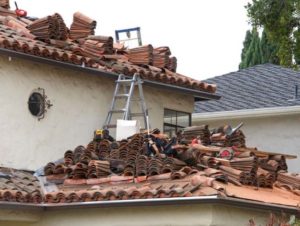Q: Our original concrete tile roof, a little east of San Diego, is around 30+ years old with a roof pitch of about 6 in 12. My guess is that the underlayment should probably be replaced before adding solar panels. The tiles are in great shape with no cracks anywhere.
The only problem is on the south end of the house where the fascia had some termites, so I cut off about a foot of the plywood and outlookers to make sure I did not see any more termites at that point. I now have only about a one foot overhang, no big deal.
Since the tiles seem to be in good condition, do you think removing the tiles, installing new underlayment, say two ply’s of 40 lb. felt , and then re-laying existing tile would be okay. Or should the tiles be replaced as well? Thanks for your advice. Any suggestions on the best solar system to tie into SDG&E’s (San Diego Gas & Electric) grid would be great. Thanks, again. – Bruce J.

A: In general, you can save several thousand dollars when reroofing by reusing your existing concrete tiles. Unless the tiles have a manufacturing defect or were poorly maintained, concrete tiles should have a 50-year-plus lifespan. How much longer they will last depends on a lot of variables. Because yours appear to be in good shape, you may get 60 years or more before they begin to fail. Cost savings from reusing tiles should be in the range of 20% to 25%.
Since your tiles are already 30 years old, you will have to weigh the pros and cons of new tiles vs “lift and relay” of the existing tiles. At 30 years, you should replace all the flashings and battens as well. Some key issues are:
- If you replace the original tiles, you will have to replace some damaged tiles and will rarely get a perfect match.
- Some tiles will be damaged during removal and storage.
- Storage of reused tiles on the roof can place stresses on the structure.
- You will not get a new product warranty on the existing roofing tiles.
Don’t Skimp On Underlayment
Since the underlayment and flashings provide the main waterproofing layer on a tile roof, and are usually the first components to fail, it makes sense to best materials you can afford. At a minimum, use a double layer of G40 underlayment, a 40-pound modified-asphalt sheet.
An upgrade to consider for underlayment is a single layer of peel-and-stick membranes, which self-seal around nail holes and penetrations. These are widely used in northern climates, but have not gained the confidence of all contractors in warm and hot climates.
Also pay attention to all flashings, valleys, hip and ridge closures, and other details that improve roof longevity. Raised battens with slots for drainage are a worthwhile upgrade that adds little cost.
Photovoltaic Options
As for PV systems, there are a dizzying array of choices in California, which leads the U.S. in solar electric installations and contractors. You can buy or lease the collectors, or use power purchase agreements (PPAs). You can also choose to use batteries or not, and choose from a wide variety of rack systems.
I can’t say which is best for you, but definitely get at least three bids, read consumer reviews, and look at BBB ratings and complaints filed with the Cal. State Licensing. Board and the Cal. Solar Energy Industries Assoc.
Always use a licensed installer. The state of California maintains an online database of licensed solar contractors .
You can read more about reusing roofing tiles at this link. –.Steven Bliss, Editor, BuildingAdvisor.com
Leave a Reply